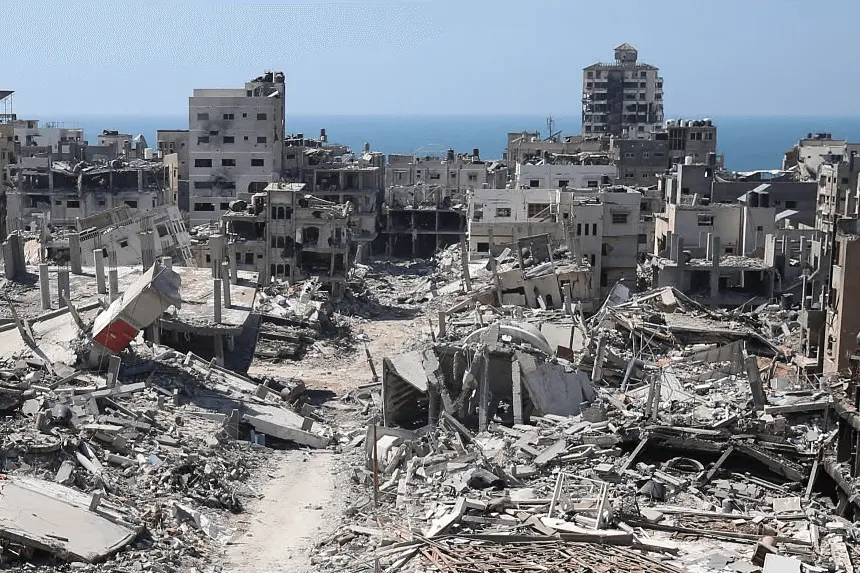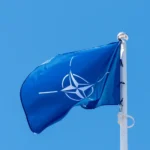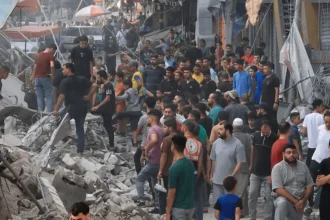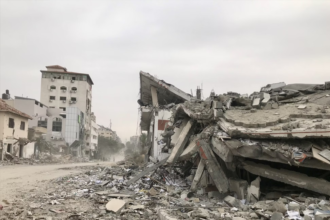Not least, 18 Palestinians were killed as Israeli drones attacked a market in Deir al-Balah, central Gaza. The strike was also said to have targeted members of a Hamas police force who wore civilian clothes and were said to be controlling shops accused of looting or price gouging. The testimonies given by eyewitnesses confirmed the gory picture, with drones firing missiles following the violent confrontation involving vendors and masked policemen.
The attack brings to the fore a bigger humanitarian crisis in Gaza, where the civilians are living under food shortages, high prices, and constant attacks. Hospital sources said the dead bodies of the victims were brought to the Deir al-Balah Al-Aqsa Hospital, and it was not yet established how many of them were police officers.
The Hamas Police were in the Market. Why?
Witnesses said the Hamas-controlled police force had been attempting to exert control over market activity, accusing certain vendors of dealing in stolen or overvalued goods. According to the reports, the commander of this unit either required a fair price or threatened to seize items.
As tensions heightened, some sellers are reported to have pulled out handguns, whilst one man had a Kalashnikov. Minutes after, the Israeli attack with drone strikes started, and the result was devastating civilian casualties. The Gaza Ministry of Interior accused the attack of being a new crime against law enforcement, attempting to ensure peace in the society. Here is the link to our article on Chernihiv Battle Readiness
What was the Response of Civilians to the Market Strike?
The scene video captured the panic of shoppers, a bloody scene, and a frantic rescue. The trauma was not left out, with ambulances rushing to be at the scene. The assault intensified the existing fear among locals struggling to sustain themselves.
It is a tragedy developing in conditions of a decline in living standards. Shortage of food and skirmishes in distribution centers have grown to be almost a daily practice. People are confronted with unsolvable solutions: staying at home to risk being shot at to receive humanitarian aid, or losing their basic needs. Is Gaza-Humanitarian Aid being misused?
The Gaza Humanitarian Foundation (GHF), sponsored by the United States, has been criticized by aid organisations for acting in the political interest instead of the concept of humanitarianism. Nevertheless, the US added an extra 30 million dollars to the organization in spite of the criticism.
Israeli Prime Minister Benjamin Netanyahu accused Hamas of stealing the humanitarian aid in the northern Gaza region. There was a video circulated with masked men who drove into Gaza in aid trucks, crossing at the Zikim crossing, which stimulated accusations of misappropriation. The footage was grasped by the far-right politicians in Israel, who used it to support ending the aid altogether.
As a reaction, Hamas and the tribal committees of Gaza rejected all the accusations of misdealing. They stressed that most aid deliveries are organized by the local tribes (not gunmen).
How is it at Aid Distribution Centers?
In central Gaza, humanitarian workers awaiting humanitarian aid close to the bridge of the Wadi Gaza were shot at, killing them all. Three Palestinians lost their lives, and some others were injured as an Israeli drone strike fired seemingly targeted a large group.
The Israeli military admitted to having fired warning shots to scare people off trying to approach troops deployed in the Netzarim corridor. There are, however, er differences between the IDF reports and local medical data, and therefore further research is necessary. Were There Other Civilian Casualties in Other Locations?
Other Israeli military actions on the same day the market was struck had also led to the death of other Palestinians. An air strike in a school serving as a shelter to displaced families in Gaza City also killed five people. In Al-Mawasi, a tent shelter under the Abu Arab family was bombarded, and five people were killed, in Khan Younis. Another attack on another refugee in the same location took away another civilian’s life. Such episodes have only worsened to spread fears among the displaced people in Gaza. The Israeli Defence Forces (IDF) claimed that they are investigating the incident, but they maintained that the operations were in focus to destroy the capabilities of Hamas. Here is the link to our article on Israel Faces Protests
What are the Roles of the WHO in the Face of this Crisis?
The World Health Organization (WHO) became the first organization that bring medical supplies to Gaza since March. The supplies, like 2,000 units of blood and 1500 units of plasma, which werelife-savingg were taken to the Nasser Medical complex in nine trucks.
WHO chief Tedros Adhanom Ghebreyesus noted that the shipment was done without looting, regardless of volatile conditions. Nevertheless, he said this was just a drop in the ocean relative to how much the medical needs were rising.
The provisions are essential. Hospitals in Gaza are filled with trauma, with many of them due to violence around the food distribution areas or aerial attacks, such as the one by the Israeli drone on Deir al-Balah.
Why Is Gaza so Adverse?
The current Israeli offensive started as a retaliation over the Hamas 7 October 2023 attack on Israel, where 1,200 Israelis were killed and more than 250 people were held hostage. Ever since, the death toll in Gaza has skyrocketed to over 56,000 according to the local health ministry.
The population of Gaza lives in a quagmire of deprivation, terror, and hopelessness as the fundamental infrastructure is riven and support is limited. In many instances, civilians (and, in some cases, children) find themselves in an opposition that is left amidst the politics of humanitarian assistance and military action.
What Is the Global Reaction to Such Occurrences?
Although the issue of civilian casualties has attracted condemnation, big governments are still assisting Israel in meeting its military agendas. In the meantime, demands for independent investigations of such incidents as the Israeli drone attack at the market and bombings of shelters and assistance queues are getting louder.
They emphasize the necessity to ensure larger protection of civilians and humanitarian workers, as well as the medical NGOs and human rights organizations. The international community (through the UN) and concerned local parties have called on warring parties to agree to a ceasefire and talks to resume.
Final Thoughts
The whole incident in the Deir al-Balah market highlights the necessity of a humanitarian break in Gaza. Since the Israeli drone strike continues to further compound a continuously increasing civilian death toll, the international community needs to insist on accountability and focus more on the safety of non-combatants. Hospitals are overburdened, relief channels are competitive, and people are always in danger of losing their lives; a sustainable solution is not only preferable, but it is crucial to the survival and healing of Gaza.








